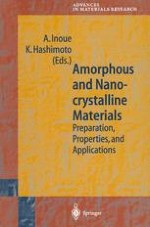2001 | Buch
Amorphous and Nanocrystalline Materials
Preparation, Properties, and Applications
herausgegeben von: Professor Akihisa Inoue, Professor Koji Hashimoto
Verlag: Springer Berlin Heidelberg
Buchreihe : Advances in Materials Research
Enthalten in: Professional Book Archive
